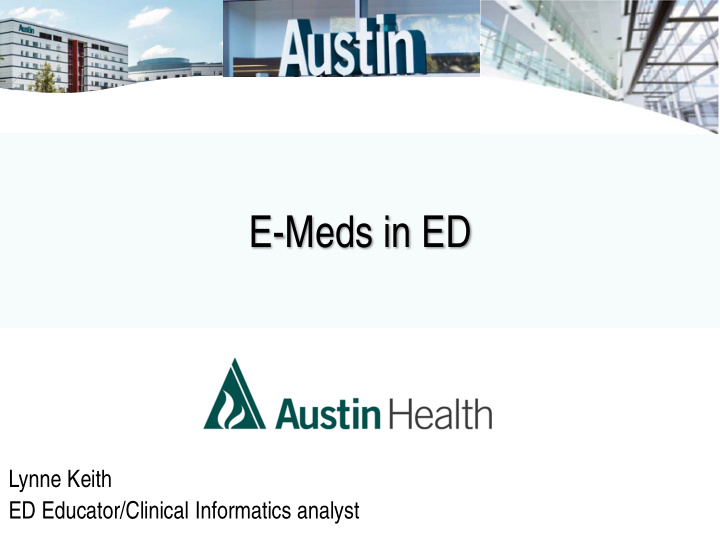



E-Meds in ED Lynne Keith ED Educator/Clinical Informatics analyst
Major Tertiary Health Provider in Northeast Melbourne 3 Campuses - The Austin Hospital - Heidelberg Repatriation Hospital - Royal Talbot Rehabilitation Centre Major Services - Liver and Gastro-Intestinal Transplantation - Spinal Cord Injuries - Oncology - Victorian Respiratory Services - Olivia Newton John Cancer Centre
93,000 Inpatient Admissions 900 Beds 176,000 Outpatients 8,000 staff 50 bed Emergency department 83,000 Emergency Attendances annually Approx. 230 Emergency presentations daily Adult and paediatric Emergency service
E-Med implementation to ED April 2013 Scope : Inclusion • Oral medications • Short Infusions – eg IV antibiotics, amiodarone • Paediatric meds • Nurse initiated meds • Discharge scripts Policy to clearly define what is out and what is in Exclusions • Continuous infusions : (One order = one bag) • Blood products
E-Med implementation to ED April 2013 Implementation • Devices one per clinician implemented 6 weeks prior to go live • Go live day at 0800 paper medication charts removed • Progressive go live only new presenting patients commenced on E-Meds • At the elbow support for clinicians by clinicians • 24hr support • Designated command center to manage and solve evolving issues
Benefits-clear legible orders
Benefits- Pre-Built Order Sentences
Benefits- Decision support
Benefits- antimicrobial prescribing guidance Entering an Approval Number is Mandatory
Benefits- SSW pathways
Benefits- Quick orders
Benefits- Transparency in Med admin/orders
Benefits • Significant decrease in error prone abbreviations on discharge prescriptions from 47.7 to 7.2 (per 100 orders) • Improved consistency between the discharge medication regimen and the discharge summary sent to the GP • Significant reduction in information that needed to be corrected/added to a prescription to ensure reimbursement by Medicare Australia • No increase in prescribing time for consultants in ED fast track • Rate of update 95% for Inpatient Discharge prescribing
Benefits • No wasting time looking for drug charts • Clear administration instructions- better patient care • Reference text available for all ordered medications • Supports streamline PBS authority • PBS information available in prescribing screens
Challenges-care sets
Challenges- Scheduled Meds
Challenges- nurse initiated analgesia
Clinical adoption success factors • Staff engaged in Change process and established their prescribing requirements in the system • Right devices at the right time- one per clinician • 100% training required and achieved either face to face or e- learning • 24hr support for 2 weeks post go live • Super users were ED doctors /nurses/pharmacists • Follow-up with any queries and address issues
Recommend
More recommend